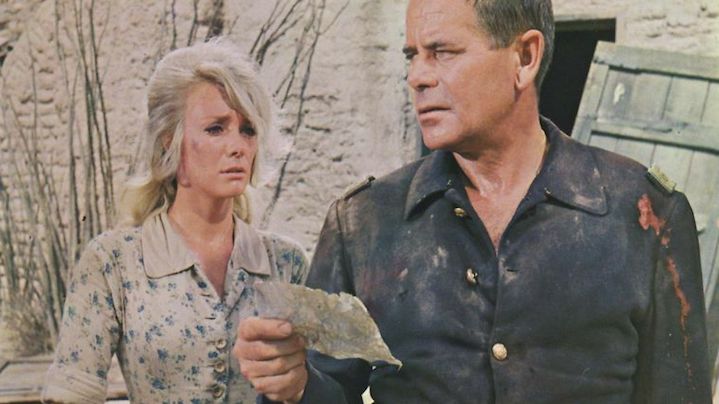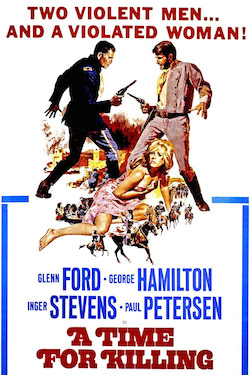
A Time for Killing (USA, 1967) 88 min color DIR: Phil Karlson, Roger Corman (uncredited). PROD: Harry Joe Brown. SCR: Halsted Welles, based on the novel The Southern Blade, by Nelson and Shirley Wolford. MUSIC: Mundell Lowe. DOP: Kenneth Peach. CAST: Glenn Ford, George Hamilton, Inger Stevens, Paul Petersen, Todd Armstrong, Max Baer, Harry Dean Stanton, Timothy Carey, Dick Miller, Harrison Ford. (Columbia Pictures)

Near the end of the Civil War, Confederate prisoners escape from a Union fort, and on the way to the Mexican border, they attack a wagon with passenger Emily Biddle (Inger Stevens), the bride-to-be of Union Major Tom Wolcott (Glenn Ford), who is also pursuing the escaped inmates. George Hamilton is quite good as Captain Dorrit Bentley, the gang’s leader whose devotion to the Confederacy is so much that he doesn’t bother telling anyone when the war ends! In Halsted Welles’ screenplay (adapted from the novel, The Southern Blade by Nelson and Shirley Wolford), the soldiers on either side of the Civil War are well aware of the futility of battle: both Blue and Gray simply want to go home.
Its anti-war sensibility would likely seem timely among young ticket-buyers who were opposed to the Vietnam draft, but still A Time for Killing is curiously old-fashioned with its classical Hollywood look (everything in the Old West is bright and beautiful). Director Phil Karlson attempts to inject realism into the film with awkwardly-framed sweaty closeups, and handheld camerawork during fight scenes (which just ends up looking sloppy). Inger Stevens is given little more to do than to look frightened and scream, and yet, her underused character haunts the narrative: highlighting the ill-treatment of women in the old frontier. Much later in the film, once she and Wolcott are re-united, after she is manhandled by Bentley, her fiancé bluntly mentions that not even a woman’s honour is reason enough to pursue the prisoners! Most of the characters are morally ambiguous: soldiers on either side of the war are cads.
A Time for Killing is perhaps more interesting on paper, since there are interesting gender and war politics that don’t get fully realized. Still, it’s not a bad flick for a drive-in double-bill. It’s more interesting to watch for its cameos by Harry Dean Stanton as one of Hamilton’s men, Dick Miller in an actually substantial role as a cowardly Union soldier, psychotic Timothy Carey as a bluebelly who likes shooting anything, and look quick for Harrison Ford in the firing squad scene near the beginning.
The legendary Roger Corman was hired to direct this film that had a bigger budget than he was used to on his AIP films, but Columbia brass (who had hired Corman for the first of a proposed three-picture deal, which went unrealized) was dissatisfied with his footage, and replaced him with Phil Karlson. Clips of this film are generously featured in the documentary Corman’s World, if to explain Corman’s estrangement with the studio system. Still, this “feels” more like a Karlson film.
